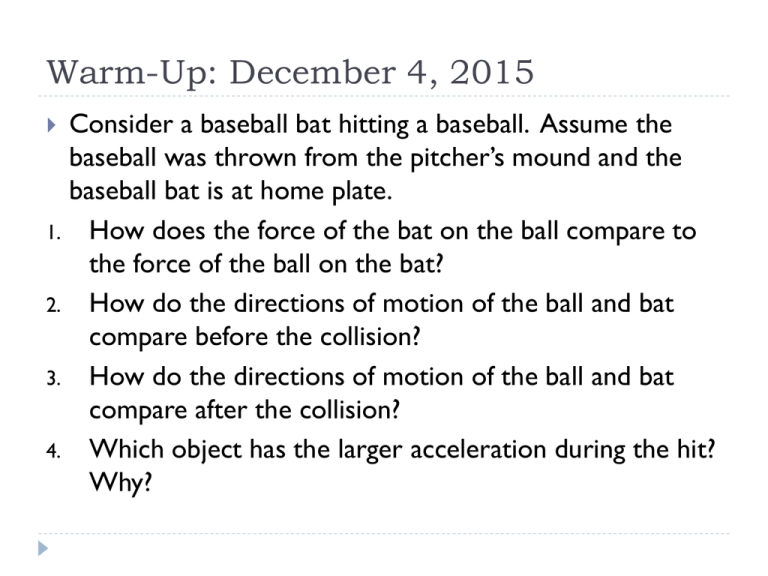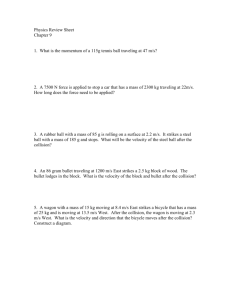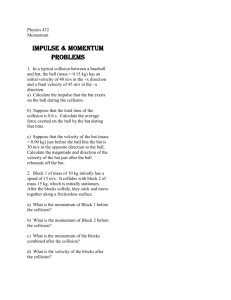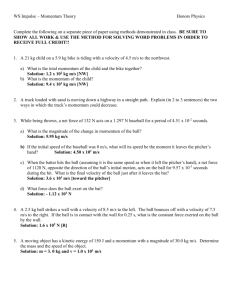Momentum - Cloudfront.net
advertisement

Warm-Up: December 4, 2015 Consider a baseball bat hitting a baseball. Assume the baseball was thrown from the pitcher’s mound and the baseball bat is at home plate. 1. How does the force of the bat on the ball compare to the force of the ball on the bat? 2. How do the directions of motion of the ball and bat compare before the collision? 3. How do the directions of motion of the ball and bat compare after the collision? 4. Which object has the larger acceleration during the hit? Why? Forces Project Due Monday If you designed your own project, resubmit your rubric with your project. Digital files may be emailed to mszwast@sandi.net if small, or brought to school on a USB drive and transferred during lunch (room 454) or after school (room 410) Forces Unit Test Answers # 1 2 3 4 5 6 7 8 9 10 11 Ver. 1 B Ver. 2 A B D D C B* D A E C B C C B C C C B B D D # 12 13 14 15 16 17 18 19 20 21 22 Ver. 1 B Ver. 2 C A C C* B C B B B C* D D C C B B A B B D C* # 23 24 25 26 27 28 29 30 31 32 Ver. 1 E Ver. 2 D A E D E E A B C* C D D A E D A B* C D Forces Test Questions? Momentum Chapter 9 Momentum p mv The momentum of an object is equal to its mass times its velocity Is represented by a lower case “p” Is a vector (has magnitude and direction) Has units of kg· m/s Equivalent to N· s Example 1 Calculate the momentum of a 103 kg linebacker running towards the quarterback at a speed of 7.5 m/s You-Try #1 Calculate the momentum of a 141 kg lineman “running” at a speed of 2.1 m/s Warm-Up: December 7, 2015 Rank the following from highest magnitude of momentum to lowest magnitude of momentum. A. A mosquito flying at its top speed. B. A car parked in a parking lot. C. A large boulder falling at its terminal velocity. D. Mr. Szwast running a marathon. Impulse J F t The impulse acting on an object is equal to the force acting on it multiplied by the time interval over which it acts Is represented by a capital “J” Has same units as momentum, kg· m/s = N· s Example 2 A 25 N force acts on a wooden box for 1.2 seconds. Calculate the impulse. You-Try #2 A man pushes a heavy sofa for 3.7 seconds with an average force of 275 N. Calculate the impulse. Impulse-Momentum Theorem The net impulse acting on an object is equal to the object’s change in momentum J net p Fnet t mv f mvi Example 3 A baseball has a mass of 0.145 kg. A pitcher throws it with a velocity of -41.3 m/s. The bat hits the ball with a force of 130 N for 0.100 seconds. What is the ball’s velocity after it leaves the bat? You-Try #3 A hockey puck has a mass of 0.115 kg. A player hits it towards the goal with a velocity of -28.7 m/s. The puck misses the goal, and instead hits the goalpost with a force of 73.6 N for 0.070 seconds. What is the puck’s rebound velocity? Momentum Worksheet On website You have the rest of class to work with your partner on the worksheet. For #10, be careful with directions and positives and negatives. If you have your project on a USB drive, bring it to Mr. Szwast. (one at a time) Warm-Up: December 8, 2015 A rocket sled is gliding across horizontal frictionless ice. It is moving at 120 m/s before it turns on a 4.0 second rocket boost that provides an average thrust of 5500 N. After the boost, the rocket is traveling at 210 m/s. What is the mass of the rocket sled? When Balls Collide… Ball A and Ball B are rolling towards each other and collide. What happens? It depends on the mass and velocity of each ball. It also depends on the conditions of the system Types of Collisions Elastic collisions conserve kinetic energy (we’ll talk about this next week). Inelastic collisions do not conserve kinetic energy. Perfectly inelastic collisions are where the colliding objects stick together and have the same final velocity. A bullet shot into a wooden block Two balls of clay that stick together System Definitions System: The set of objects which are being analyzed. Closed system: A system in which no mass enters or leaves the system. Isolated system: A system with no net external forces (or small enough to be negligible). Conservation of Momentum The momentum of any closed, isolated system does not change. For two objects in one dimension: m1v1 m2v2 initial m1v1 m2v2 final Example 4 A black ball with mass 1.4 kg and velocity 1.7 m/s is rolling towards a stationary gold ball with mass 0.40 kg. After the collision, the gold ball’s velocity is 1.5 m/s. What is the final velocity of the black ball? You-Try #4 A white ball with mass 1.0 kg and velocity 1.0 m/s is rolling towards a blue ball with mass 0.75 kg and velocity -1.5 m/s. After the collision, the white ball’s velocity is -0.15 m/s. What is the final velocity of the blue ball? Example 5 A bullet with mass 0.025 kg and velocity 550 m/s is shot into a 20.0 kg stationary wooden block that is on frictionless ice. The bullet gets lodged in the block and they travel together. What is the speed of the block and bullet? You-Try #5 Two cars are driving towards each other. One has a mass of 1200 kg and a velocity of 24 m/s. The other has a mass of 1350 kg and a velocity of -19 m/s. The collision causes the two cars to be stuck together. What is the velocity of the two cars after the crash? Example 6 Two clay balls are on a collision course. One ball, with mass 1.5 kg, is traveling north at 4.8 m/s. The other, with mass 2.3 kg, is traveling east at 3.2 m/s. The two balls of clay stick together when they collide. What is the velocity of the clay after the collision? Example 6 Assignments Classwork: Conservation of Momentum Worksheet On website Work with your partner Homework : Read Chapter 9 Page 235 #7-9 Page 250 #32-34, 38, 40, 57, 73, 80 Warm-Up: December 9/10, 2015 A 1.7 kg rock is thrown into a stationary ball of clay at a speed of 3.2 m/s. The rock gets stuck in the clay and they move together at a speed of 2.3 m/s. What is the mass of the clay? Momentum and Impulse Worksheet 1) 3.8 10 4 kg m s 2) 260 kg 3) 7.4 4) 5) 6) 7) 8) m s 220 N s 23 N 0.21 s 2s 70. N 9) 6.0 m s 10) 1.1103 kg Collisions in Two Dimensions Momentum in conserved for each dimension Use conservation of momentum equation for 𝑥 direction, and again for 𝑦 direction. Add the resulting vectors (using trig) to find the final velocity (magnitude and direction). Example 6 Two clay balls are on a collision course. One ball, with mass 1.5 kg, is traveling north at 4.8 m/s. The other, with mass 2.3 kg, is traveling east at 3.2 m/s. The two balls of clay stick together when they collide. What is the velocity of the clay after the collision? Example 6 You-Try #6 A 35.0 gram bullet is shot north at 475 m/s at a moving target. The target is a 25.0 kg block of wood that is sliding to the east at 4.2 m/s along frictionless ice. The bullet gets stuck in the block of wood. What is the final velocity of the block of wood? You-Try #6 Assignments Classwork: Conservation of Momentum Worksheet On website Work with your partner Homework : Read Chapter 9 Page 235 #7-9 Page 250 #32-34, 38, 40, 57, 73, 80









